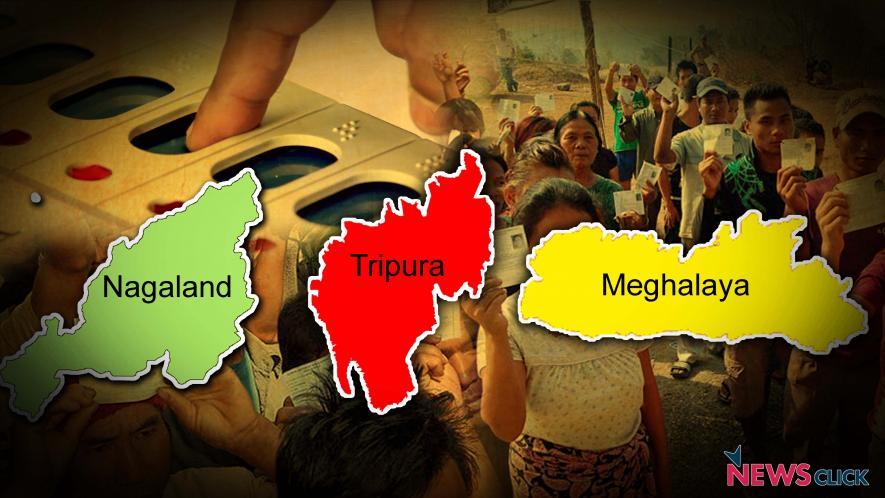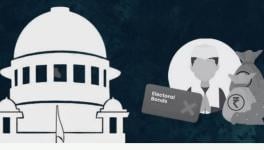Election Strategy or Intelligence Strategy?

Newsclick Image by Sumit
According to reports, the National Security Advisor, Ajit Doval attended a meeting with BJP and RSS functionaries at the Union Home Minister’s residence allegedly to discuss the BJP’s election strategy in the Northeast, with special focus on the three upcoming elections viz. Meghalaya, Nagaland and Tripura. The CPI(M), through Bijan Dhar from Tripura, alleged that election strategy was discussed. Although no direct evidence is available about the proceedings, current political developments in the concerned states reveal plenty of circumstantial evidence.
The current NSA has operational experience in the Northeast, in Mizoram and Sikkim specifically. However, the broad intelligence strategies that Govt. of India adopted to deal with dissent in the Northeast is the same, with minor alterations to suit each situation. The main thrust of intelligence operations is to find among the ‘rebels’ a few individuals who can compromise on the broad demands, then seek to split or coerce the organizations to which they belong.
The Shillong Accord which was signed between the Government of India and the then ‘Naga Army’ led by the Naga National Council (NNC), was seen by many as selling out the sacrifice of the Naga people. The Accord was vehemently opposed by Angami Zapu Phizo, the father of the Naga national movement and leader of the NNC. According to Kaka D. Iralu, the first split in the Naga movement was the result of playing up the tribal rivalries between the Angami and the Sema Nagas. Phizo was an Angami. A section of the NNC led by Thuingaleng Muivah and Isak Chishi Swu along with Shangwang Shangyu Khaplang formed the National Socialist Council of Nagaland (NSCN). The NSCN later split along the lines of ‘Indian’ and ‘Burmese’ Nagas, with Swu and Muivah forming the Isak-Muivah faction and Khaplang forming the Khaplang faction. The current Framework Agreement consists of groups that are predominantly made up Nagas on the Indian side of the border. NSCN(K) abrogated the ceasefire and has become a member of the UNLFW.
Mizoram is a state which has become synonymous with deft negotiations and bringing insurgents to the mainstream. The Mizo National Front led by Pu Laldenga signed the Mizoram Accord with the Rajiv Gandhi led Congress Government. However, here too there were elements within the MNF who opposed the Mizo Accord on the ground that they were committed to ‘sovereignty’. However, they were soon routed by the security forces, and Laldenga became the first Chief Minister of Mizoram. The Hmar, whose traditional territory was split, did not subscribe to the Accord. The Hmar are located between Assam, Manipur, Meghalaya, Mizoram and Tripura. This resulted in the formation of the Hmar People’s Convention, which lateer split into several factions. One of these factions Hmar People’s Convention (Democracy) (HPC(D)) in currently in negotiations with the Union Government. The reason for the dissatisfaction with the Accord was that the Hmar people thought their territory too would be included within the new state of Mizoram.
In Assam, the pan Assamese nationalist insurgent group, the United Liberation Front of Assam (ULFA) saw a split when the Chairman Arabinda Rajkhowa along with several ranking members such as Hira Sarania and Anup Chetia came over ground to initiate peace talks with the Union Government. However, the Military Commander Paresh Baruah has refused to enter into talks which has caused ULFA to split into the ‘pro-talks’ and ‘anti-talks’ factions, the anti-talk faction being renamed ULFA(I), with ‘I’ meaning ‘independent’.
This is a pattern that can be seen in the political alignments in the states nearing elections. In Tripura, the BJP has allied itself with the IPFT. This has caused other Tripuri ethno-nationalist parties to seek an alliance with the Congress. This is ironical because, with a substantial section of tribals supporting the Left Front, the remainder opposing it will now get split between the BJP and the Congress. About a third of Tripura’s population is tribal.
In Nagaland, the NDPP has declared an alliance with the BJP, while it was speculated that the NPF was severing its ties with its long-time ally, the BJP. However, some intense backroom maneuvering led to the NPF, on January 23, rescinding its earlier decision to sever ties and instead announcing that the alliance with the BJP was still on.
In Meghalaya the situation is somewhat different. The state parties PDF, HSPD and GNC have formed an alliance in the upcoming elections. However, the last time a state party formed the government in Meghalaya was between 2008 and 2009, when Donkupar Roy of the UDP became the Chief Minister. Since then, Meghalaya has been a Congress bastion. The battle lines appear to be drawn primarily between BJP and National People’s Party (NPP), though the two parties are in alliance at Parliament, and also in Manipur. The NPP, though called a ‘national’ party, is primarily based in the Northeast, with Conrad Sangma, a Garo from Meghalaya being the party leader. The BJP has never formed the Government in Meghalaya, and therefore in this instance with no clear alliance with the NPP, it appears that the NPP may play spoiler to the game plan.
Get the latest reports & analysis with people's perspective on Protests, movements & deep analytical videos, discussions of the current affairs in your Telegram app. Subscribe to NewsClick's Telegram channel & get Real-Time updates on stories, as they get published on our website.
























